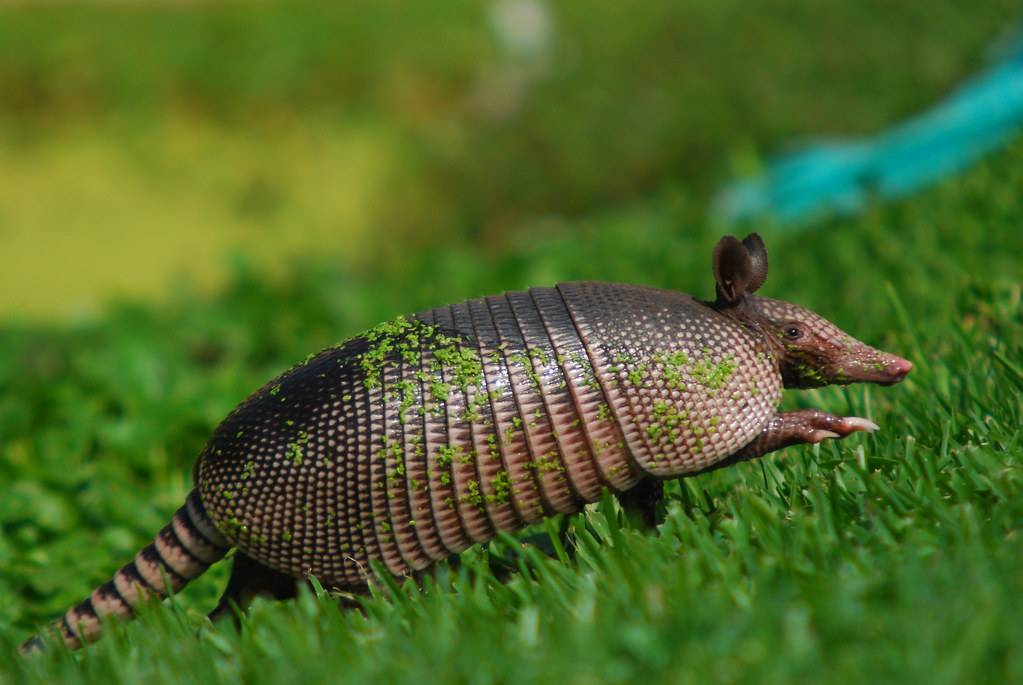Armadillo Removal
Armadillos, specifically the Nine-banded armadillo, have been increasingly spotted in Kentucky since the early 2000s, with sightings becoming fairly common in counties as far east as Land Between the Lakes (LBL). They are solitary, nocturnal animals, feeding primarily on insects, but also small reptiles, bird eggs, and baby mammals. Armadillos are not aggressive toward people or other wildlife but may scratch or bite if handled. They can carry leprosy, which is transmissible to people, so contact with armadillos should be kept to a minimum.
Armadillo control methods include fencing, applying soil insecticide to control the armadillo’s food resources, and trapping. Traps can be set along pathways to burrows and along fences or other barriers where armadillos may travel. However, homeowners should be aware that there is seldom a quick and easy fix to any wildlife damage problem. Often the cost (time and money) of control exceeds the damage caused.
In terms of cost, the prices for wildlife pest control in Lexington, KY can vary depending on the size of the job and other factors. Small jobs start from $150+, medium jobs from $300+, and big jobs from $600 and up.
Key Takeaways
- Armadillos are nocturnal creatures that are primarily active at night.
- They are solitary animals, preferring to live alone except during the breeding season.
- Armadillos are excellent diggers and create burrows and underground tunnels for shelter.
- They have a keen sense of smell and primarily feed on insects, grubs, and other invertebrates.
Armadillo Behavior and Habits
Armadillos, primarily active during the night, have unique habits distinct from many other animals. These solitary creatures typically only come together for mating purposes. A notable aspect of their behavior is their tendency to dig. They construct elaborate burrows and underground tunnels, which serve as their homes and provide protection.
Their diet mainly consists of insects and small invertebrates, which they track down using their well developed sense of smell. This foraging habit sometimes brings them into human-inhabited areas, where they can unintentionally damage gardens and lawns.
Armadillos have the ability to swim, which aids them in crossing small streams or ponds when necessary. However, this swimming ability isn’t a major factor in their overall behavior or range expansion.
When armadillos venture into residential spaces, they inadvertently cause issues with their digging habits. This can affect lawns, gardens, and occasionally, structural foundations. To manage this, especially in urban Lexington areas, professional wildlife control services need be hired. Armadillos can be extremely difficult to trap and remove with out the correct bait or species specific traps.
Armadillo Trapping
Armadillo trapping methods primarily involve the use of armadillo specific wooden traps but can be done with cage traps, which should be placed in strategic locations such as armadillo pathways. Armadillos are more likely to enter the trap if it is placed in a location they frequently travel.
One common technique is to use wooden planks or temporary fencing on either side of the trap opening in a “V” shape to guide the armadillo into the trap. If using a one-door trap, it is recommended to position the trap so that the open door faces the burrow entrance. Baiting the trap is optional and its effectiveness is debated among trappers. Some find that bait attracts unwanted critters to the trap, while using specific lures attract armadillos with a high success rate.
Trapping armadillos can be extremely challenging for homeowners due to their behavior and habits, it’s highly advised to contact a local wildlife control company for professional assistance.
Signs of Armadillo Infestations
The presence of armadillos in residential areas can be identified through distinct signs of infestation. Here are some signs to look out for:
- Burrows: Keep an eye out for large, conical holes in the ground. Armadillos are known for digging burrows as their shelter, so these burrow entrances are a clear sign of their presence.
- Garden and Landscaping Damage: Armadillos are notorious for digging in search of food, which can result in damage to gardens and landscaping. Look for signs of disturbed soil and uprooted plants, as these can indicate armadillo activity.
- Claw Marks: Armadillos have three-toed claws, and they can leave distinct claw marks in the soil or mulch. Look for these marks as evidence of their presence.
- Small Holes: Armadillos create small holes as entrances to their dens. If you notice small holes around your property, it could be a sign of an armadillo infestation.
If you suspect an armadillo infestation on your property and need professional removal, give us a call today (859) 595-5908.
Armadillo Damage
Armadillos, known for their exceptional digging abilities, can cause significant damage to yards, gardens, and structures. They dig holes up to three inches deep and five inches across, often giving the appearance of turf being peeled away from the surface. They can also destabilize foundations, driveways, and other structures by digging for grubs, earthworms, and insects. In addition, armadillos can damage trees by burrowing near them and damaging the root structure.
Armadillos are notorious for creating complex burrowing systems below ground, which can disrupt grass or dirt areas and potentially endanger the stability of structures like concrete slabs, creating air pockets that may lead to cracks. Burrows can also be hazardous for humans and livestock due to the ground instability they cause.
For damage to structures like foundations and driveways, it’s crucial to contact professionals who can assess the damage and provide appropriate solutions. This might involve reinforcing the structure, filling in the burrows, or other repair methods.
Citations: [1] https://fw.ky.gov/Documents/Armadillos_in_KY-June_2023.pdf [2] https://extension.okstate.edu/fact-sheets/tips-for-managing-nuisance-armadillo.html [4] https://www.kentuckyliving.com/explore/the-armadillo-invasion [10] https://www.murrayledger.com/news/local/biologists-say-armadillos-are-here-to-stay/article_1a3dea1e-2275-11ed-85b0-777e1095b598.html [11] https://icwdm.org/species/other-mammals/armadillos/armadillo-damage-prevention-and-control-methods/ [13] https://spectrumnews1.com/ky/louisville/news/2023/09/22/experts-say-kentucky-s-armadillo-population-is-on-the-rise [18] https://www.lexingtonky.gov/dead-animals [19] https://animalia.bio/nine-banded-armadillo?taxonomy=5917


